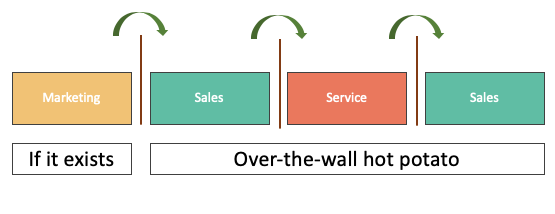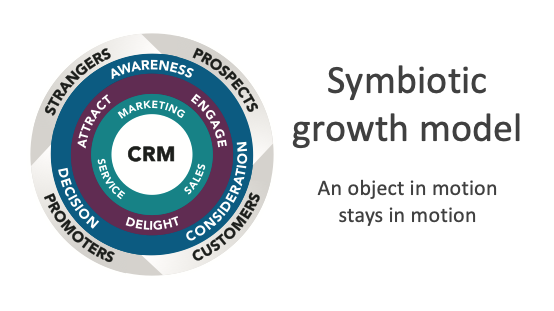Share article
Every agency has two basic goals: keep the business they have and get the business they don’t. Because of those goals, most agencies tend to structure their growth model and plans around those two operational areas – sales and service.
Do they REALLY want to grow?
When I ask agencies to define their most critical measure of success in a given year, they almost always identify it as the amount of new business they need to write. However, when I ask that same agency which most accurately describes their agency, “Are they more of a sales or service organization?” most will respond with an emphatic SERVICE. In fact, most feel service is the one thing that most differentiates them from their competition.
Sure, there are those who are more aggressive sales organizations, always focused on writing new business, but they are rare. Even more rare are the agencies who recognize there has been a critical operational function missing from their structure, MARKETING.
Let’s talk about how agencies align these operational functions to establish their growth model and how that model needs to shift.
Reactive growth model
 Whether they embrace marketing or not, most agencies operate in a very siloed, reactive growth model. It’s as if they have built walls between the operational functions. And, if any particular discipline is successful, they toss the results of their success over the wall to the next operational function, just hoping someone is there to catch it. Even if there is someone, they are typically starting from scratch.
Whether they embrace marketing or not, most agencies operate in a very siloed, reactive growth model. It’s as if they have built walls between the operational functions. And, if any particular discipline is successful, they toss the results of their success over the wall to the next operational function, just hoping someone is there to catch it. Even if there is someone, they are typically starting from scratch.
If marketing is successful in generating a prospect, they toss it over the wall to the sales team, but the sales team has no idea as to why they became a prospect. And, if the sales team is successful at acquiring a new client, they toss that new client over the wall to the service team, but the service team rarely knows why they became a client or what their expectations are that need to be met.
Proactive growth model

At the very least, agencies need to SHIFT to a proactive growth model. In this model, agencies start to tear down the walls and have smoother handoffs between their key functions. Most agencies likely feel they have achieved this model, but it is shocking how few truly have.
The key to having a proactive model in place is to have key processes defined, documented, and consistently executed. Those key areas are:
- marketing process
- sales process
- the way they onboard a client
- the way they service those clients
- and the manner in which they renew their client
If you don’t have defined, documented, and consistently executed processes in these key areas, you have yet to fully make this shift.
Sure, the proactive growth model is an improvement over the reactive model, but, even though there are smoother handoffs, each function is still operating in too much of a siloed manner.
A key component of any growth model is the pipeline of prospects, often following the concept of a sales funnel. Visually, the funnel appears to be effective and efficient. It looks as though any opportunity that goes into the top will eventually come out the bottom as a new client. Unfortunately, this is very misleading.
What we refer to as sales funnels are usually much more like a kitchen strainer, with opportunities being lost along the way. And, it is beyond difficult to keep feeding the big end of a kitchen strainer. It’s time to recognize the inefficiencies of the traditional funnel.
Symbiotic SHIfT
 The reactive and proactive models are built from an internal perspective. It’s time to shift our growth models to one with that starts with the buyer in mind, a symbiotic growth model.
The reactive and proactive models are built from an internal perspective. It’s time to shift our growth models to one with that starts with the buyer in mind, a symbiotic growth model.
We also need to create internal operational efficiencies by ensuring that not only does each function not operate in a silo, but that they operate in a symbiotic fashion. We must ensure that each function operates at a higher level than it could on its own because of the interdependent relationship that needs to exist with the other functions.
Let’s look at your growth model as a math equation.
- In the proactive model, 1 + 1 + 1 (marketing + sales + service) = something less than 3 (there are still inefficiencies from silos).
- In a reactive model, 1 + 1 + 1 = something SIGNIFICANTLY less than 3. You can imagine how much gets dropped when it’s tossed over the wall blindly.
- But, in a symbiotic model the result is something significantly GREATER than 3 and I will explain how.
I understand this model looks a bit overwhelming at first glance, but I believe you will come to see that each level, and each section on each level, are absolutely critical areas of focus when it comes to growth.
Start with the buyer in mind
Let’s focus on just a couple layers at a time.
The biggest difference between the Symbiotic model and others is that it starts with the buyer in mind.
In their relationship to you, it recognizes that all buyers exist in one of four stages. They are either a stranger, a prospect, a client, or a promoter.
It also recognizes that all buyers go through the same basic buying journey.
- At some point, the buyer becomes AWARE that their situation can be improved.
- When they decide that want that improvement for themselves, they move into a CONSIDERATION phase where they research available solutions.
- Eventually, they make a DECISION as to which solution/partner is the best fit for them.
Notice that this model is a closed loop, whereas the others were linear. This is recognition that buyers go through this cycle repeatedly. Even existing clients will repeat this process as they become aware of new needs/opportunities.
Now we can talk about you
With an understanding of the Buyer’s Journey, you’re now able to align your operational functions and goals accordingly.
We need to stop thinking about ourselves as a Sales or Service organization and recognize we have to commit to being a growth organization. An organization with common, shared goals.
- Your first goal should be to ATTRACT the buyer’s attention as they become aware of a need or opportunity,
- Your next goal is to ENGAGE them in conversation through dialogue and content as they are evaluating and making decisions.
- And the final goal should be to create a client experience that results in them not simply being satisfied with their decision to work with you, but in being DELIGHTED with their choice.
These goals are not the responsibility of any single function, they are shared across all operational functions. But of course, even though the goals are shared, each operational function has primary areas of focus.
Symbiotic marketing
Marketing has the responsibility to help attract and engage the buyers.
Marketing’s first goal is to create content that speaks to the needs of the buyer. Often times it is the content created by marketing that leads to the new awareness in a buyer and sets them on their buyer’s journey. Other times, because marketing so clearly understands the needs of the buyer, they create content that is found through an active buyer’s search.
As the buyer moves to the consideration stage and starts to more actively look for solutions, marketing is also responsible for creating content that speaks to potential solutions and helps the buyer see a path to improved results.
Using technology, marketing also creates and documents a profile of each buyer, monitoring their interests (what blogs did they read, what content did they download) and level of engagement (how frequently are they consuming your content).
Now, when it’s time to introduce the prospect to the sales team, sales has a very thorough understanding of who they are talking to and why.
Symbiotic sales
It is up to the sales team to further engage the buyer and to start setting them up for an eventual delighted client experience.
The sales team enters the picture while the buyer is still in the consideration phase, evaluating their available solutions. Already having an understanding of the buyer’s concerns, the first goal of the sales team is to bring a sales process that defines the goals of the buyer, further explores already identified needs, and expands on the needs analysis to complete the buyer’s picture.
Of course, it is also the sales team’s job to move the buyer to the decision phase and convince them that you are the obvious partner they need to work with. Sales does this by introducing specific solutions to address specific needs and building a detailed plan of improvement that leads to better results and becomes the framework that, when executed, will ensure a delighted client experience.
By the time the prospect commits to becoming a client, their desired client experience has been documented and that plan is handed off to the service team for execution.
Symbiotic service
The service team is responsible to deliver a client experience that delights the client but also helps ensure our delighted client helps attract new buyers.
With a clear understanding of the new client, their needs, the promised solutions, and documented client expectation, the service team can more effectively onboard that new client. They are also able to lay out a service plan that ensures success and leads to the promised results.
With expectations clearly defined, the service team is able to interact with that client systematically to ensure the needs are addressed and results achieved. When the client experiences significantly improved results in their business, they are delighted, and retention goes up.
Not only does retention go up, your delighted client now helps you attract new prospects into the process.
Symbiotic execution
We broke the model down from the outside moving in. Let’s piece the whole thing back together and review how it all works together, starting from the inside.
A symbiotic growth model ensures that marketing, sales, and service enhance one another’s effectiveness with the recognized goals of attracting, engaging, and delighting their buyers. It is built on an understanding of the journey through which all buyers pass, repeatedly.
Organizations that commit to this type of model will find themselves consistently attracting more strangers, more effectively and efficiently converting them into prospects, more effectively and efficiently converting them to customers, and more consistently creating client promoters.
In today’s word-of-mouth world, those promoters not only help you attract more strangers, they help you attract the RIGHT strangers, strangers who aspire to have the same type of delighted experience enjoyed by your promoters. Imagine how attracting the right strangers at this rate makes the overall process that much more efficient and effective.
Let’s go back to the growth equation for a moment. This is how 1 + 1 + 1 in a symbiotic model equals something significantly greater than 3. Not only do you have every member of your team performing at a peak level, you’ve now expanded your team by adding your promoters. And, your promoters, your best clients, are always going to be your best marketers.
It’s time to get your SHIfT together
If you want the right results, there is no waiting. Today is the day to commit to a healthier growth model.
SHIFT happens all the time, but, if you want it to be the RIGHT SHIFT, you have to make it happen.

